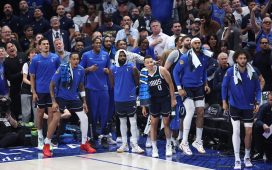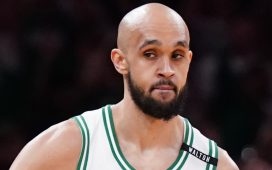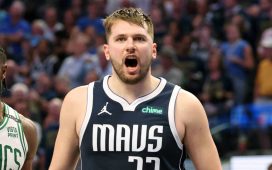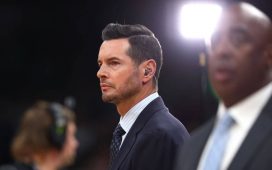As the NBA closes in on a new media rights deal, much of the attention has been on what it means for the league and its teams. But there’s also another beneficiary of the set of deals that will reportedly pay the league an average of $6.9 billion over 11 years: the players.
Those new deals — whether they end up with Warner Bros. Discovery, NBC or Amazon as partners alongside Disney – should more than double the current deals, which are slated to pay the league roughly $3 billion next season in the final year of its contracts with Disney and Warner Bros. Discovery. While not guaranteed, the expectation among team executives is that the salary cap will rise the maximum allowable 10 percent over the first seasons under the new media landscape, which will begin with the 2025-26 season.
The amount of money set to pour into the league will likely bring about what surely was once considered an impossible feat: the $100 million salary.
NBA players are already amassing wealth like never before. Any player part of the 2022 draft class will have the opportunity to make more than $1 billion alone in NBA contracts, before any endorsements or sponsorship deals. If the cap keeps rising as projected, a player might be able to make that much over the course of two contracts in his prime. Jaylen Brown’s record-setting contract, which could be worth as much as $304 million, could look small by comparison.
The NBA could have its first $100 million salary by the 2032-33 season. That’s assuming a salary cap of $141 million next season, as the league currently projects, and then 10 percent cap-raises after that.
Under that forecast, the salary cap would hit more than $302 million, which would allow a number of players to cross the $100 million threshold. For example, a player in the first year of his supermax contract, which pays 35 percent of the cap, could make as much as $105.79 million during the 2032-33 season — that’s double the league-high $51.9 million Stephen Curry made this season. A player in the second year of a supermax contract that kicked in the season before could make $103.86 million that season. A player in the third year of a supermax contract that began during the 2030-31 season could make $101.41 million.
The size of the contracts will be eye-popping. A five-year supermax deal that begins with the 2030-31 season will be worth $507 million under these estimates. One that begins the next season will be worth $557.78 million. The supermax that kicks in during the 2032-33 season would be valued at $613.56 million.
Projected NBA Supermax Contracts
| Season | Projected Cap | 35% Max Salary | Supermax Deal |
|---|---|---|---|
|
24-25 |
$141 million |
$49.35 million |
$286.23 million |
|
25-26 |
$155.1 million |
$54.29 million |
$314.85 million |
|
26-27 |
$170.61 million |
$59.71 million |
$346.34 million |
|
27-28 |
$187.671 million |
$65.68 million |
$380.97 million |
|
28-29 |
$206.438 million |
$72.25 million |
$419.07 million |
|
29-30 |
$227.082 million |
$79.48 million |
$460.98 million |
|
30-31 |
$249.79 million |
$87.43 million |
$507.07 million |
|
31-32 |
$274.769 million |
$96.17 million |
$557.78 million |
|
32-33 |
$302.246 million |
$105.79 million |
$613.56 million |
Those numbers could be overly generous, of course. Maybe the cap doesn’t go up 10 percent every year, and salaries don’t go up so quickly. While the national media rights could account for roughly 30-40 percent of all basketball revenue when they kick in, the local media revenue seems set to dip — and who knows what other issues might pop up.
That timetable might also be too slow. Either the NBA or the NBPA could opt-out of this CBA by Oct. 15, 2028 and that would trigger a new CBA for the 2029-30 season. What if that CBA doesn’t have cap-smoothing and has no ceiling on how quickly the cap can go up? Or, it gets rid of the rule that sets max salaries at 35 percent of the cap? Get ready for some big numbers.
NBA commissioner Adam Silver and president of global content & media distribution Bill Koenig have surely made a lot of people happy. The league’s still-new collective bargaining agreement was written with a new media rights deal in mind and this should allow the NBA to have labor peace through the end of this CBA, set to run until 2030 if no one opts out. There was always a small chance that the NBA would ever have to execute the opt-out clause it has in the current CBA that lets it get out of the agreement if its media income fell to a certain threshold compared to what it took in during the 2022-23 season. But with such large numbers on the horizon, the league — and its players — is approaching even loftier wealth.
Since it’s never too early to talk about the offseason — at least that’s what every TV segment about the NBA tells me — it’s a good time to remind everyone about this summer’s hottest read: the CBA.
Some of the most restrictive parts of the new CBA are set to come in next season and the new cap year starts on July 1. They will color how teams act this summer.
Starting with the first day after the just-concluded regular season, teams above the first apron ($172.346 million) can only trade for a player who makes up to the value of the salary they are dealing away. Any traded player exceptions first-apron teams generated over the past year will no longer be usable unless they get back down below the apron.
Teams above the second apron ($182.794 million) can no longer aggregate player salaries — that provision kicked in with the end of the regular season. Those teams cannot send out their own player in a sign-and-trade, and they can’t send cash in a trade.
The “frozen pick” rule will go into effect next season. If a team is above the second apron on the last day of the 2024-25 regular season, then its first-round pick seven years out (2032) cannot be traded. If that team is above the second apron in two of the next four years, that frozen pick will also be moved to the end of the first round in that year’s draft. A team can unfreeze its pick if it is below or equal to the second apron in at least three of the next four years.
If a team does one of the things listed above, then it will be hard-capped at the apron threshold it has yet to cross.
If a team pulls off a trade between the end of the regular season and the start of the new cap year with a maneuver that is not allowed for teams above the first or second apron, then that team will be hard-capped for the rest of the current salary cap year and the next one. But the new CBA does allow teams some flexibility because that doesn’t kick in until after the 2024-25 regular season; teams can still have their total salaries go above an apron level between the end of the 2023-24 regular season through June 30, 2024 without being hard-capped.
There is also a new concern for teams that don’t hit the salary floor. Starting with the 2024-25 season, teams that don’t hit the floor won’t receive any of the money paid out to non-taxpaying teams.
Beginning on July 1, teams will now be able to use the non-taxpayer midlevel, the room midlevel or the biannual exception to trade for one or multiple players or acquire a player on a waiver claim (the player’s contract can’t exceed the max length allowed by that exception). The exception won’t be able to get aggregated.
Teams will also get more latitude with extend-and-trade contracts. On July 1, those will be able to go up to a total of four years and 120 percent of the prior salary.
(Photo: David Berding / Getty Images)





